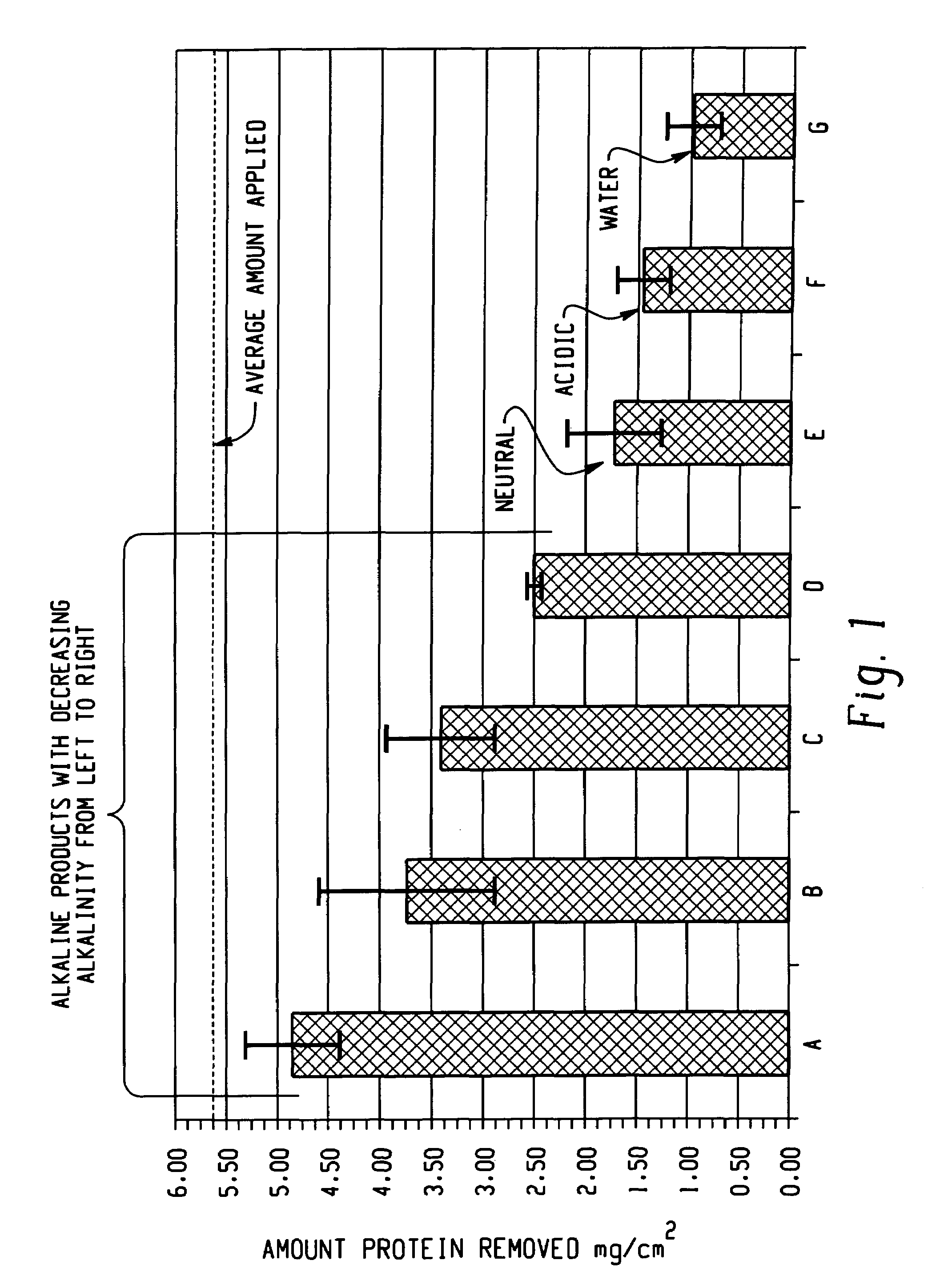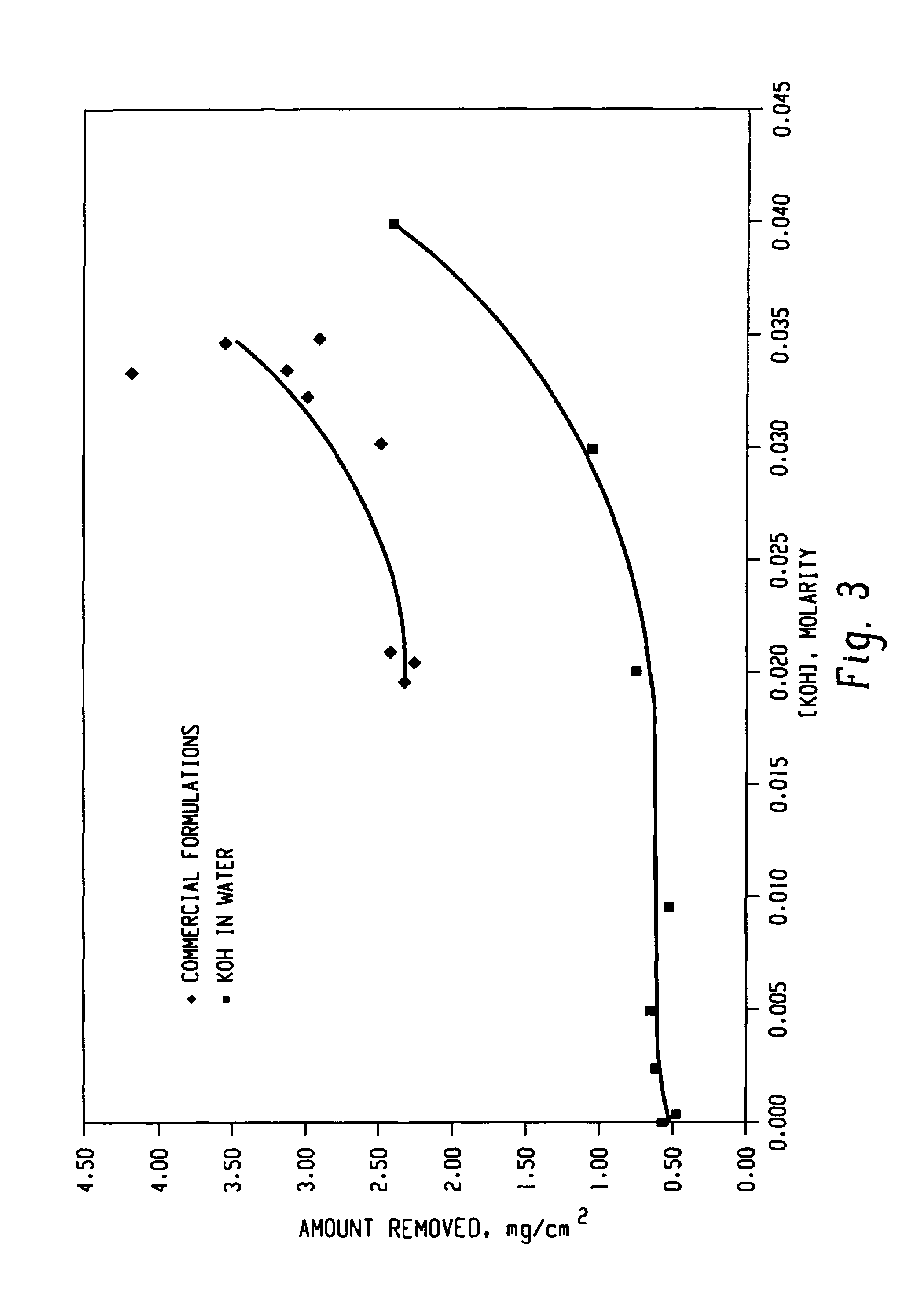Decontamination of surfaces contaminated with prion-infected material with oxidizing agent-based formulations
a technology of oxidizing agent and prion, which is applied in the direction of detergent compounding agent, ampholytes/electroneutral surface active compounds, biocide, etc., can solve the problem of prion carrier status, neuronal cell death, and relative rapid neurological degradation, and achieve rapid and effective deactivation of prions. , the effect of gentle on instruments
- Summary
- Abstract
- Description
- Claims
- Application Information
AI Technical Summary
Benefits of technology
Problems solved by technology
Method used
Image
Examples
example 1
[0067]Coupons were prepared by treating them with a prion model (a BSA denatured protein). The coupons were then treated with a composition containing 1,000 mg per liter concentration of peracetic acid at temperatures from 40°–60° C. The composition also contained a surfactant system, a phosphate buffering system, an organic corrosion inhibitor, and a chelating agent. The composition was free of heavy metals.
[0068]TABLE 4 summarizes the amounts of BSA broken down during a 12 minute exposure to the composition.
[0069]
TABLE 4Percent ProteinBreakdown at 1000 mg / LTemperature (° C.)Peracetic Acid00301401451509055996080
[0070]The results indicate that little, if any, protein breakdown occurred at 40° C. and 45° C. At 50° C. and 55° C., the proteins were effectively broken down. At 60° C., some protein residue remained, suggesting clumping. That is, at temperatures of about 60° C. and above, the protein aggregates and protects itself with higher resistance to attack by peracetic acid or othe...
example 2
[0074]Coupons of a prion model in the form of ileal fluid dependent organisms (IFDO) were treated with peracetic acid formulations as described in Example 1, having peracetic acid concentrations from 0–2,000 mg per liter, at 50° C., and then cultured in a modified Mycoplasma base broth. An aliquot of the IFDO suspension was added directly to 1,000 mg per liter, 1,500 mg per liter, 2,000 mg per liter, and 2,500 mg per liter peracetic acid solutions at 50° C. The models were then incubated at 37° C. for 48 hours in the modified Mycoplasma broth. FIG. 5 illustrates the log of the prion model versus time for 0; 1,000; 1,500; 2,000; and 2,500 mg per liter solutions. Because higher levels of material on actual instruments can degrade peracetic acid, an initial concentration of 2,500 mg per liter peracetic acid is preferred.
example 3
[0075]Coupons of a prion model in the form of ileal fluid dependent organisms (IFDO) were treated with peracetic acid formulations at 1,500 mg per liter at various temperatures, ranging from 25 to 60° C., and then cultured in a modified Mycoplasma base agar as described in Example 2. FIG. 6 illustrates the log reduction of the prion model versus time at 25, 30, 40, 45, 50, 55, and 60° C., respectively. It is considered that the formulation was optimal at temperatures greater than 50° C. However, due to the possibility of protein coagulation at temperatures greater about 60° C. (as demonstrated in TABLE 4), the optimal temperatures for prion denaturation would be 50–60° C., more specifically 53–57° C.
PUM
| Property | Measurement | Unit |
|---|---|---|
| Temperature | aaaaa | aaaaa |
| Temperature | aaaaa | aaaaa |
| Temperature | aaaaa | aaaaa |
Abstract
Description
Claims
Application Information
 Login to View More
Login to View More - R&D
- Intellectual Property
- Life Sciences
- Materials
- Tech Scout
- Unparalleled Data Quality
- Higher Quality Content
- 60% Fewer Hallucinations
Browse by: Latest US Patents, China's latest patents, Technical Efficacy Thesaurus, Application Domain, Technology Topic, Popular Technical Reports.
© 2025 PatSnap. All rights reserved.Legal|Privacy policy|Modern Slavery Act Transparency Statement|Sitemap|About US| Contact US: help@patsnap.com



